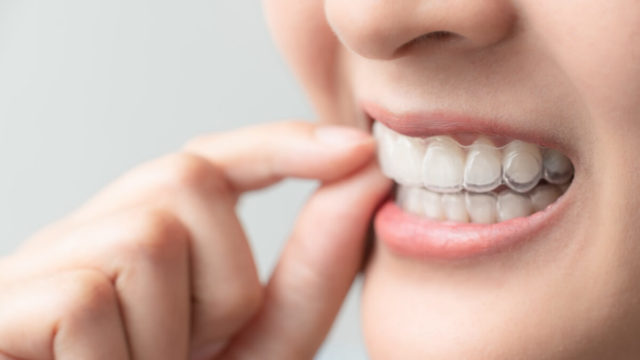Clear aligners make an excellent alternative to traditional braces. Unfortunately, not all clear aligners are equal. There’s a significant difference between orthodontic treatment and at-home aligners such as SmileDirectClub and Candid. Let’s take a look at the key differences and why those DIY braces may not be the best option.
What Are At-Home Aligners?
Home aligners, also known as DIY aligners or home teeth straightening kits, promise to straighten your teeth for less. The companies market their DIY kits as more affordable than traditional orthodontic methods.
How Do Home Teeth Straightening Kits Work?
With at-home aligners, you do everything on your own and mail everything back and forth with the company you choose. Though the process may vary slightly, you can expect most at-home aligner brands to approach the process similarly.
Step One: Impressions and Images
First, you would purchase a kit from them to see if you are a candidate for their product. Each kit contains detailed instructions about what you need to provide, including images of your teeth from various angles. You also receive materials to make impressions, usually a doughy-type material and mouthpiece.
Note that some companies have retail sites in some cities, so you may be able to go in for 3D scans instead. However, it’s not always possible.
Step Two: The Evaluation
Once you have the images and impressions complete, you send everything back to the company. Each company has dental professionals on staff to review the molds and images to see if you are a candidate. This process can take a few weeks to complete, and they accept the majority of cases.
Step Three: The Aligners
After the dental professional approves you, they construct a proposed treatment plan. These treatment plans include digital images of your teeth and how they could shift over time. If you agree with the proposed treatment plan, you can purchase the at-home aligners.
At-home aligners cost somewhere between $1500 and $2500 on average, and many of the companies offer financing plans. Your aligners should arrive within a month or two after you pay.
Step Four: Follow the Plan
Your home teeth straightening kit should arrive with several trays and detailed instructions to follow. Generally, you need to wear the trays for at least 22 hours each day, meaning you only remove them to eat or drink. You can only drink plain water while wearing the trays, so planning your meals is crucial.
Some companies ask you to send updated images at varying intervals to document progress. You can also stop treatment at any time, but most companies don’t offer refunds.
Step Five: The Retainers
If you want your teeth to stay in position, you need to wear a retainer for at least a year after you complete the treatment plan. Some companies include retainers in your package, but others charge an additional fee.
Do At-Home Teeth Aligners Work?
These DIY teeth straightening kits work for some people. They can only straighten teeth to improve the aesthetics of your smile. Some people don’t see the results they need and many others see their teeth move back.
Are Home Teeth Straightening Kits Safe?
Safety is an issue with at-home aligners. The American Dental Association (ADA) has voiced concerns about DIY teeth straightening due to safety concerns.
Since you don’t physically visit a dental professional at any point during your treatment, you could develop tooth decay or gum disease. Even if you go this route, you must maintain regular visits with your dentist to have your teeth and gums checked.
Further, the trays are purely for cosmetic purposes and only custom-made to a degree. They cannot correct bite or structural issues, and they can rub and irritate your gums in ways traditional clear aligners do not.
At-Home Aligners vs. Invisalign
At-home aligners can be an affordable option for people who only need them for cosmetic reasons. However, they come with some hefty downsides, especially when compared with orthodontist-guided clear aligners, like Invisalign.
1. Consults and Check-Ups
Unlike the at-home aligners, Invisalign requires an in-person consult, and a dental professional takes any necessary images or impressions. Plus, you have appointments with your dental team several times throughout your treatment, meaning they monitor your progress and watch for signs of trouble.
2. Fit
With DIY teeth straightening kits, you take the impressions and images or make your way to a retail store, so results may not be as accurate. Plus, the at-home aligners don’t necessarily fit around your gums, so they can cause irritation. Since you can’t go to a dental professional, there’s nobody to adjust them for you.
A dental professional takes your images when you choose Invisalign. The trays are truly customized for your mouth, so they fit comfortably over your teeth.
3. Results
Many of the DIY companies boast fast results, some as low as six months. However, they only offer cosmetic adjustments that don’t seem to last as long as traditional orthodontics.
Invisalign is a flexible option that can accommodate elastics and some orthodontic appliances throughout treatment. That means Invisalign can correct more than cosmetic issues, including bite misalignments.
4. Cost
At first glance, at-home aligners seem like a no-brainer since they are so cheap. However, unless you only need minor cosmetic straightening, it may not save you as much in the long term. If your teeth shift back after completing treatment, you develop other issues, or have uncorrected bite problems, you could need traditional braces or Invisalign anyway.
The Bottom Line on At-Home Aligners
It may be tempting to take the cheaper route to a straighter smile, but it’s not necessarily the best or safest option for most people. Having a dental professional monitor the process from consult and imaging to completion and beyond ensures a safer, more consistent outcome.
Before jumping into any DIY teeth straightening programs, it may be worth your time to check out Invisalign. You can get removable clear aligners and the support you need for successful treatment.
Jefferson Dental & Orthodontics offers free orthodontic consultations and affordable Invisalign clear aligners or traditional braces options. We even have affordable payment plans as well as a Dental Savings Plan to help you pay for your orthodontic treatment. Contact the office nearest you to book an appointment today!




